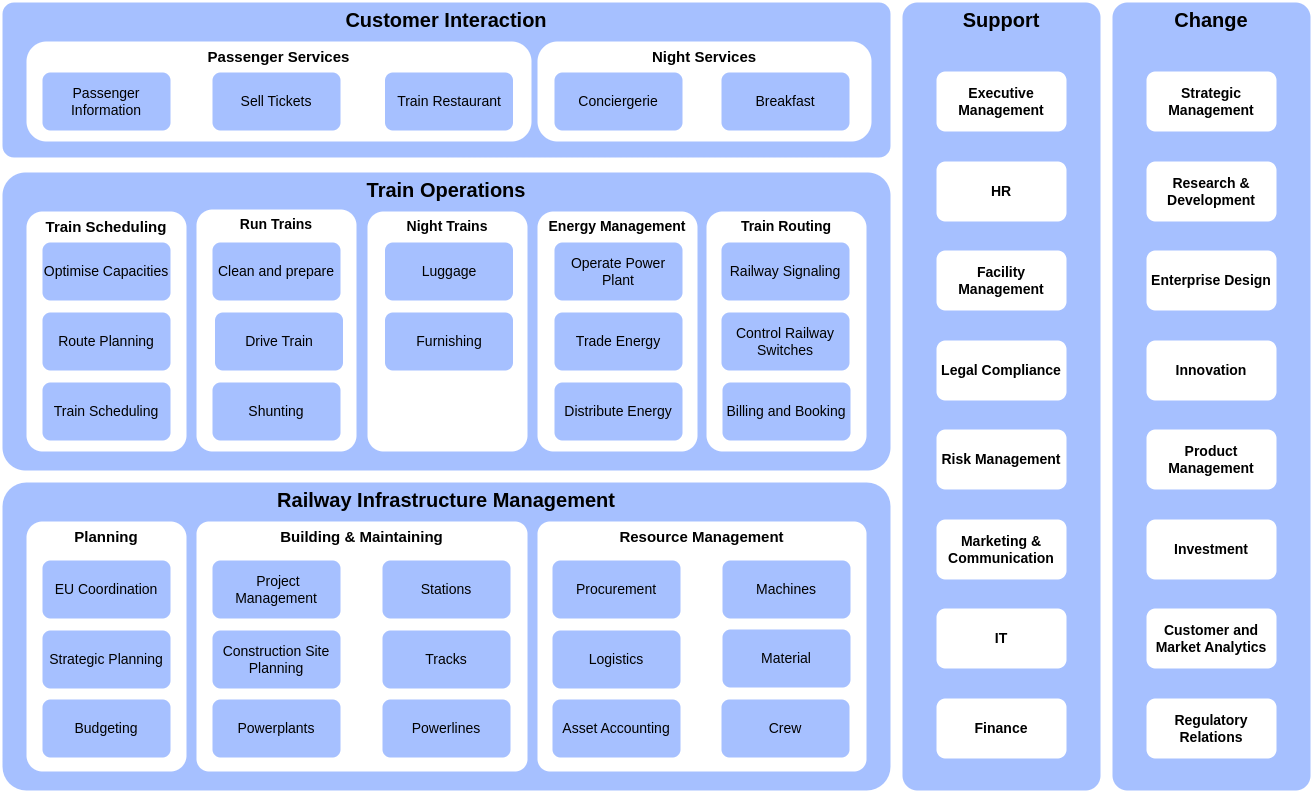No edit summary |
No edit summary |
||
| (42 intermediate revisions by the same user not shown) | |||
| Line 1: | Line 1: | ||
< | <small>[[Enterprise Elements]] | [[Facet and Intersection Elements]] | {{element|Ar Icon-Architecture|Architecture}}</small> | ||
==<span class=" | ={{element|Ar Element-Capability|Capability}}= | ||
<span class="Ar Def">What we are able to do by orchestrating people and assets.</span> | |||
==Description== | ==Description== | ||
Enterprises strive to achieve their purpose by creating products that | [[Enterprises]] strive to achieve their [[purpose]] by creating [[products]] that feature in [[people]]'s [[experiences]]. To do so, they must design and realise their capabilities by orchestrating meaningful combinations of people and [[assets]]. Each capability produces well-defined [[outputs]] for internal or external business use and contributes directly or indirectly to product creation. | ||
feature in people's experiences. To do so, they must design and realise | |||
their capabilities by orchestrating meaningful combinations of people | Capabilities guide the modularisation of our enterprise by defining boundaries around what "belongs together" and what is distinct from other capabilities. By deriving the realising [[processes]] and assets (such as the required [[organisation]] and [[application|applications]]), a well-designed capability model leads to enterprises and organisations that are adaptive to change. Capabilities can be decomposed into sub-capabilities (usually levels 1-3) to create a hierarchy. Each capability must have a clearly assigned business owner to ensure its strategic development and the effective creation of intended outputs. | ||
and assets. Each capability produces well-defined outputs for internal | |||
or external business use and contributes directly or indirectly to | |||
==Capability Map== | |||
[[File:EDGY-Capability-Map.png|EDGY Enterprise Business Capability Map]] | |||
[[ | Depicting a [[tree]] relationship. Also known as Business Capability Map | ||
==Examples== | ==Examples== | ||
| Line 31: | Line 23: | ||
==Use== | ==Use== | ||
*Clarify what needs to be done and the assets your people need to do that. | *Clarify what needs to be done and the [[assets]] your [[people]] need to do that. | ||
* | *To achieve intended [[outcomes]], focus your resources on the right [[outputs]] to contribute to. | ||
*Define clear | *Define clear ownership for governance structures based on capability boundaries. | ||
*Design your operations for efficiency and business adaptivity. | *Design your operations for efficiency and business adaptivity. | ||
*Create a common terminology. | *Create a common terminology. | ||
==Base element== | |||
*{{element|Ar Element-Capability|capability}} is an {{element|Element-Outcome|outcome}} | |||
==Related== | ==Related== | ||
* | *{{element|Pr Element-Product|product}} requires {{element|Ar Element-Capability|capability}} | ||
* | *{{element|Or Element-Organisation|organisation}} has {{element|Ar Element-Capability|capability}} | ||
* | *{{element|Ar Element-Capability|capability}} requires {{element|Ar Element-Asset|asset}} | ||
* | *{{element|Ar Element-Process|process}} realises {{element|Ar Element-Capability|capability}} | ||
==Suggested labels== | |||
*in-house, outsourced ([[tagging|tag]]) | |||
*innovating, differentiating, commodity ([[tagging|tag]]) | |||
*cost ([[metric]]) | |||
*performance ([[metric]]) | |||
== | {{#seo: | ||
|description=In EDGY, a capability is a what we are able to do by orchestrating people and assets. EDGY is Intersection Group's Open Source tool for collaborative Enterprise Design. | |||
|keywords=Capability Map,Business Capability,Capabilities,Capability Management,Capability Development,Enterprise Capabilities | |||
|image=EDGY-Capability-Map.png | |||
|image_alt=EDGY Enterprise Business Capability Map | |||
}} | |||
Latest revision as of 18:37, 8 June 2023
Enterprise Elements | Facet and Intersection Elements | Architecture
Capability
What we are able to do by orchestrating people and assets.
Description
Enterprises strive to achieve their purpose by creating products that feature in people's experiences. To do so, they must design and realise their capabilities by orchestrating meaningful combinations of people and assets. Each capability produces well-defined outputs for internal or external business use and contributes directly or indirectly to product creation.
Capabilities guide the modularisation of our enterprise by defining boundaries around what "belongs together" and what is distinct from other capabilities. By deriving the realising processes and assets (such as the required organisation and applications), a well-designed capability model leads to enterprises and organisations that are adaptive to change. Capabilities can be decomposed into sub-capabilities (usually levels 1-3) to create a hierarchy. Each capability must have a clearly assigned business owner to ensure its strategic development and the effective creation of intended outputs.
Capability Map
Depicting a tree relationship. Also known as Business Capability Map
Examples
- A national government develops the capability to warn citizens about potential environmental dangers.
- A railway service operates its own power plants and power lines to distribute energy across their network.
- A technology company sets up a government relations capability to affect upcoming regulation.
- A design studio excels in its digital product design practice, building upon research and prototyping capabilities.
Use
- Clarify what needs to be done and the assets your people need to do that.
- To achieve intended outcomes, focus your resources on the right outputs to contribute to.
- Define clear ownership for governance structures based on capability boundaries.
- Design your operations for efficiency and business adaptivity.
- Create a common terminology.
Base element
- capability is an outcome
Related
- product requires capability
- organisation has capability
- capability requires asset
- process realises capability
Suggested labels
- in-house, outsourced (tag)
- innovating, differentiating, commodity (tag)
- cost (metric)
- performance (metric)
